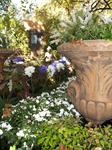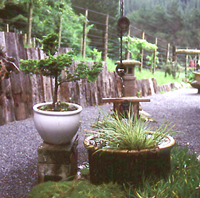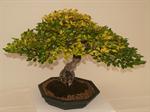Pots In The Garden Landscape

Pots in the garden landscape can create pleasing effects in a variety of ways. They can provide extra colour or focus to a garden, they can extend garden space into living areas making the boundary between inside and outside less distinct. They can reflect surrounding vegetation, and make allusions to nature through careful use of particular plants such as bonsai.
Choose the style and colour of your pots to suit both your plants and the style of garden. In most cases, look for contrasts between the pot colour and the flowers or foliage. Either choose a pot with a neutral or subdued colour to display bright flowers or foliage, or a bright coloured pot to display green foliage.
Think carefully about using very colourful pots containing very colourful plants. Be careful not to choose pots that compete.

Using Colourful Pots
When you set up your pot display, think of the surrounds, especially the colour and texture of the ground surface and backdrop. Look for backgrounds that complement or contrast with the pot colour. Also consider changing light conditions throughout the day and how this might affect the visual impact of the pot. A dark coloured pot can look dramatic when it’s in full sunlight, but will appear drab if it remains in shade for most of the day.
Don’t group too many different coloured pots together – the effect will be probably be jumbled and unattractive. Using one or two colours in a repeated pattern (eg. matching coloured pots evenly spaced along the edge of a patio) will give a more pleasing design.
Pots without plants
Ways to use pots without living plants:
· A single colourful pot or a cluster of empty pots can be used to hold dried or fresh flowers on a verandah or indoors. If using fresh flowers, place the flowers in a container filled with water (such as a jar or plastic soft drink bottle) and sit it inside the decorative pot.
· Large pots can be turned upside down with a plank on top to make a bench.
· Large tubs can be used as a water feature. Choose a tub without drainage holes and place a rubber liner inside to prevent water leaking.
· Bird baths can be an attractive feature

Want to Know More?
Consider doing a course or buying a reference book from our school.
More from ACS
Ebook - Inspiring: covers formal, natural, eclectic, modern, oriental, Mediterranean; zoom in on stunning images and plans.
View eBook
Ebook - Explores garden design ideas and inspires
garden design and landscaping!
View eBook
Ebook - A classic that has helped many to start up and run a successful business.
View eBook
Course - Popular design certificate that has launched many enthusiastic and talented design students into the industry.
View Course
Course - The opportunities for green walls and roofs will only increase as our cities continue to grow.
This is a solution to environmental and commercial problems on so many levels.
View Course